Nintendo’s long-awaited Switch console has arrived, alongside the even more long-awaited New Zelda. The Switch combines the convenience of a handheld with the power of a home console — or at least, that’s the pitch. And while the two roles make considerable compromises in order to accommodate one another, the result may be said to be more than the sum of its (many) parts. Or at least it could be once a few games come out.
At a glance
- 6.2″ capacitive 720p touchscreen
- 2 removable wireless controllers
- Dock with HDMI out for “console mode”
- 32GB of storage
- MicroSD slot
- $299; available for preorder today, launches March 3
One-upping the competition
The Switch may very well be Nintendo’s Hail Mary in the console business. After the Wii U failed to make itself comprehended by consumers, the company was left scrambling while Sony and Microsoft solidified their biumvirate in the gaming world. Now the latter two are locked in combat over timed exclusives, framerates, and basically showing how hardcore they are — not a fight Nintendo has ever wanted to get in the middle of.
After the Wii U, no one was about to suggest doubling down on weirdness. Yet a traditional console would not only be a crushing defeat to Nintendo’s experimental nature over the last decade, but it would be too little, too late to compete with the PlayStation 4 and Xbox One. And over this landscape the grim specter of the smartphone loomed, ever siphoning away the hours and dollars of Nintendo’s erstwhile superfans…
What to do? Nintendo’s solution, while it has its shortcomings, is a remarkably cohesive and smart one.
The Switch is a home console that can compete directly with the PS4 and Xbone on some levels, but it’s also a handheld system that exceeds the capabilities of existing systems and smartphones. It attempts to please all of the people — but thankfully stops short of trying to do so all of the time. It’s a huge gamble, but the more you think about it, the more it seems like the only bet they could have made.
So what is it again?
If you haven’t been paying attention to the ceaseless coverage of the Switch these past few months, here’s a quick rundown of the system.
Entirely contained in a nameless, Kindle-sized tablet-like device (Nintendo calls it “the main unit,” which seems a missed opportunity), the Switch has two modes. When it’s plugged into your TV via its dock, it acts like a regular gaming console: the two small wireless controllers (insensibly called “Joy-Con R” and “Joy-Con L”) can be held individually or attached to a grip and you have your ordinary big screen experience.
But when you want to head out, you grab the tablet and pull it out of the dock — boom, your game continues on the built-in screen immediately, right where you were. Not a video stream running through the cloud, not a pared-down mobile version — the same exact game, running on the same hardware, just a different screen.
You can attach the controllers to the sides of the tablet to make a single unit, or prop up the screen with its kickstand and play with them in your hands. Each controller can also be used independently by multiple players, so you can do some split-screen Mario Kart or what have you just by handing your friend one “half” of the two-part controller you use to play Zelda single-player.
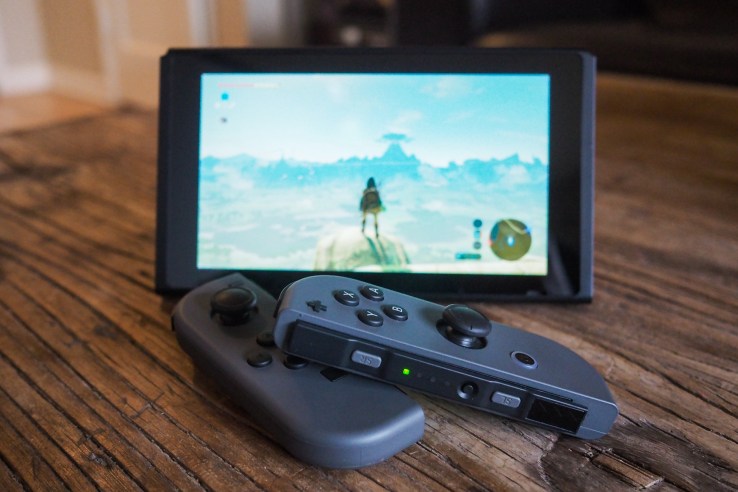 Switch units can also be linked together wirelessly for up to 8-person multiplayer, although we didn’t have a chance to test this.
Switch units can also be linked together wirelessly for up to 8-person multiplayer, although we didn’t have a chance to test this.
Something you didn’t know you wanted
I own a PS4, Wii U, 3DS, smartphone, PC, Famiclone, and numerous other gaming platforms. But the Switch almost immediately felt like something that was missing until now — something midway between a “real” console and a “real” handheld.
It was a small but substantial “Eureka” moment: I’d been playing Zelda for a couple hours like I’d play a normal console game, and I was vacillating between going to bed and finishing whatever task I was occupied with in the game. “Wait,” I thought. “I can do both!” Without trying, I’d stumbled upon one of the many situations where you’d like to play a game but don’t feel like sitting down in the same spot staring at your TV. Later I experimented with playing the switch reclining on the couch, as if it were my 3DS, and propped up next to my PC while I worked. (Oh, like you never secretly got your game on at the office.)
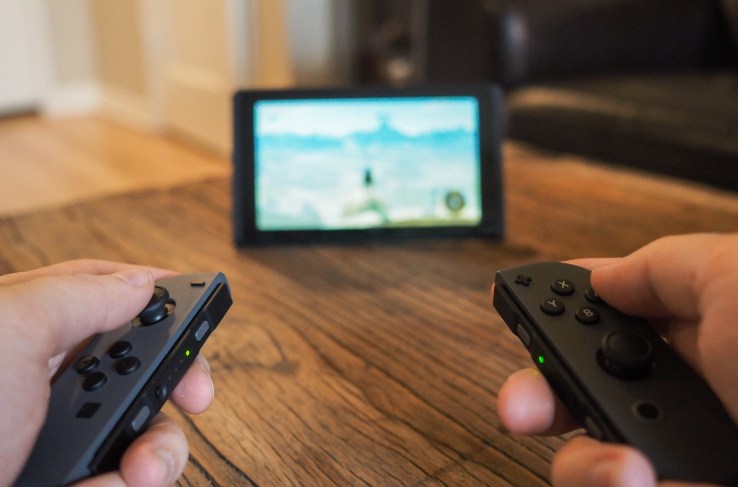 I found myself automatically segmenting the game and my time more effectively. I used the less-intense handheld mode in spare moments to explore idly and accomplish the inevitable mundane tasks you encounter in games: sorting inventory, crafting, reading lore. But when work and dinner were done and I wanted to tackle that dungeon I’d spotted between calls, in a handful of seconds I was in hardcore mode: lights out, big screen, speakers blasting.
I found myself automatically segmenting the game and my time more effectively. I used the less-intense handheld mode in spare moments to explore idly and accomplish the inevitable mundane tasks you encounter in games: sorting inventory, crafting, reading lore. But when work and dinner were done and I wanted to tackle that dungeon I’d spotted between calls, in a handful of seconds I was in hardcore mode: lights out, big screen, speakers blasting.
No other consoles do this (apart from some cumbrous streaming solutions), and now it feels like they’re missing something. Why can’t I do my gear comparisons in Final Fantasy XV in bed? Why doesn’t Fire Emblem have a big screen mode I can use for those climactic battles?
This is the thing Nintendo has going for it — well, that and Zelda. And Mario. And Splatoon. The Switch truly offers different value. Because of the way the market is right now, people are unlikely to buy both a PS4 and an Xbox — even the upgraded versions of those consoles are hard sells except to very motivated gamers. But the Switch is something different from both, with different games and different ways to play them. It didn’t take me long to find out that was something I didn’t even know I’d wanted.
Actual review time
“Yeah yeah,” I hear you saying, “spare me the woolgathering — how does this thing actually play?” Well then, Mr or Mrs I’m-in-such-a-hurry, I’ll get to it.
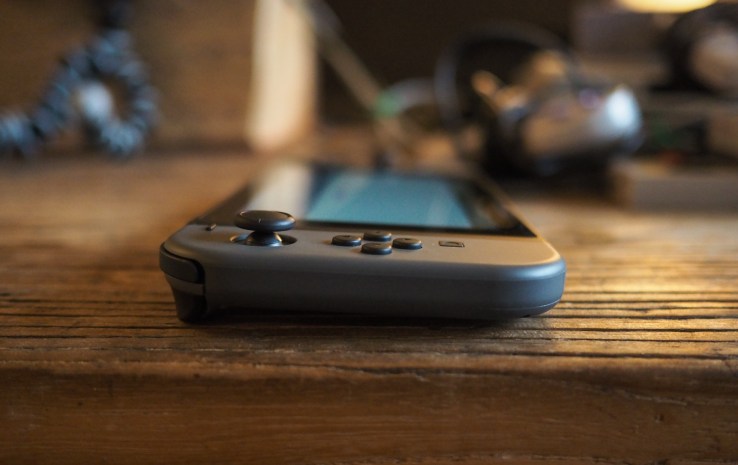 The Switch console itself measures about 8 inches across by 4 inches tall, and half an inch thick — about the size of a Kindle or small tablet. Comparisons to the Wii U’s controller are not unwarranted, but the difference is like night and day, and I’m not just talking about the color. While the Wii U’s controller felt like a Playskool toy with its plasticky screen and marshmallowy curves, the Switch is like a premium smartphone: thin, very well made, and while not quite fragile, fragile-feeling enough that you don’t want to find out exactly how fragile it is. I have a feeling Switch armor will be a thing soon.
The Switch console itself measures about 8 inches across by 4 inches tall, and half an inch thick — about the size of a Kindle or small tablet. Comparisons to the Wii U’s controller are not unwarranted, but the difference is like night and day, and I’m not just talking about the color. While the Wii U’s controller felt like a Playskool toy with its plasticky screen and marshmallowy curves, the Switch is like a premium smartphone: thin, very well made, and while not quite fragile, fragile-feeling enough that you don’t want to find out exactly how fragile it is. I have a feeling Switch armor will be a thing soon.
Familiar features adorn the edges of the tablet: power, volume, slots for the cartridge and Micro SD, speakers at the bottom, and a vent at the top. The sides look a bit raw because that’s where the rails are that the controllers attach to.
Games are the size of SD cards and stick into the top right corner there. Wait times to read and load games were as good as non-existent. I wasn’t able to test speeds from internal storage or any kind of file management, though.
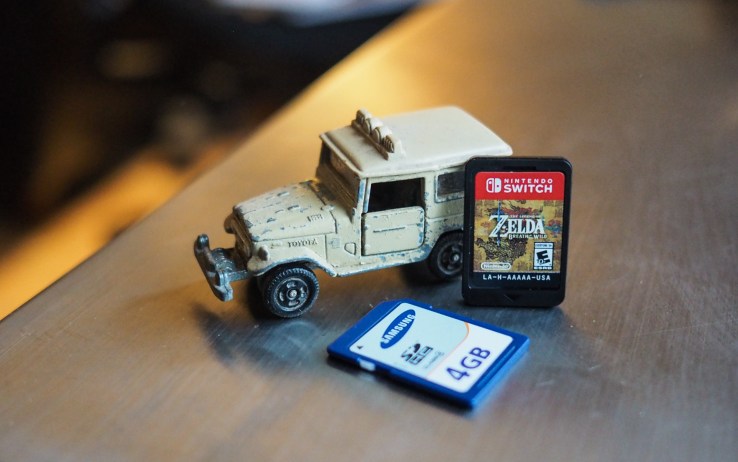 The tablet fits into a dock for console mode. This dock is a lightweight plastic thing, and slotting the Switch into it is simple but not at all satisfying. It kind of clatters in there and maybe half the time goes straight onto the hidden USB-C connector. The other half you miss by a quarter inch and wince as you think about how many times it’ll take before something snaps in there. It also wobbles a bit and would definitely fly out if the dock was tipped over. Got to be honest with you: this thing isn’t worth the $90 they’re charging for a spare. Of all the parts of the Switch, this connection seems the most likely to fail, so do yourself a favor and be careful with it.
The tablet fits into a dock for console mode. This dock is a lightweight plastic thing, and slotting the Switch into it is simple but not at all satisfying. It kind of clatters in there and maybe half the time goes straight onto the hidden USB-C connector. The other half you miss by a quarter inch and wince as you think about how many times it’ll take before something snaps in there. It also wobbles a bit and would definitely fly out if the dock was tipped over. Got to be honest with you: this thing isn’t worth the $90 they’re charging for a spare. Of all the parts of the Switch, this connection seems the most likely to fail, so do yourself a favor and be careful with it.
Sliding the Joy-Con (TM) controllers onto the tablet is a considerably more pleasant experience. Not only do they slide securely and precisely along their grooves, but they make a nice, tactile little click at the end — accompanied not only by a snapping sound effect from the tablet — but a subtle on-screen effect indicates each one is locked in place. Once in, they’re in for good — I never felt once that the display part was coming loose or had trouble or grit when putting the other pieces in place. Pro tip: pull them down by the bottom, don’t push from the top. You’ll avoid hitting buttons that way.
When joined with the “main unit,” the Switch feels like a single piece of hardware, and while it isn’t ergonomically perfect (it’s hard not to hit buttons while you’re putting it down or moving it around), it is very nice. It’s light (under a pound) and thin — perhaps slightly too thin, giving those with larger hands little to grip.
Taking the controllers off isn’t quite the frictionless process portrayed in commercials, but it is easy. You hold the release button on the back (I never did by accident) and they come away — sometimes catching a bit, and if you’re not careful, lifting the whole thing off the USB-C connector. There’s a technique to it, and don’t try to do both at once.
The controllers themselves, let us admit, are too small. (Banana for reference.)
I have medium-to-large hands, so your mileage may vary, but really, these things are tiny. Each one is smaller than the grip of a Dual Shock controller, and they pack a lot of little buttons on there. Any games that require you to use the face and shoulder buttons will leave your hand a gnarled claw if you’re not careful. There are little caps with wristbands attached that help with this slightly, but not much. I expect third-party caps to ease this problem as well.
Despite being small, however, the controllers are very well made and comfortable as long as complex interactions are kept to a minimum. I will tell you that selecting arrows in Zelda is one of these interactions and I avoid it if at all possible. You have to hit down the right trigger with your right index finger, then hold down the left d-pad button with your left thumb, while moving the right analog stick with your right thumb. It’s like a cross between finger wrestling and Twister. I implore developers to find alternatives like gestures.
The included Comfort Grip is a decent way to avoid some of these problems, but I actually felt happy most of the time without it, since I could move my hands independently for things like aiming arrows. Improved or adjustable grips are inevitable and will be welcome. If you like it, consider grabbing the $30 charge grip — also handy if you plan on having more than the basic two controllers.
Motion controls, from what I was able to test in Zelda, feel smooth and accurate. For example, I thought I would discard the motion bow aiming as a clever novelty, but it’s become a lifesaver. I’ve never been a good at right-stick aiming, and this lets me do that quickly then fine tune it seamlessly and reliably with a flick of the wrist.
1-2 Switch gave me the opportunity to test the IR rangefinder, but only in an elementary fashion (i.e. it works as far as I can tell). We’ll have to see what developers make of it. The HD rumble shows more promise; one minigame has the controller imitate a small box in which a number of marbles are hidden, and which you must count by rolling them around and feeling the vibrations. It was surprisingly — almost eerily — effective and I think game designers are going to… have a ball.
Battery life is as stated by Nintendo, and will vary by game. I got about two and a half hours at max brightness in Zelda. I haven’t had the controllers run out of battery yet (they supposedly last 20 hours), so clearly it’s super easy to keep them charged. Each game will probably have its own average, and using wireless should pull down a predictable amount of power as well. Don’t expect all-day gaming, but do feel free to trust Nintendo’s estimates.
The OS is remarkably straightforward in every aspect I encountered. Some tutorial items had a bit of personality, and you can still make Miis, but they don’t run around your screen or anything. Options are minimal — the usual user management, Wi-Fi, etc — and there’s an always available quick settings overlay (brightness, sleep, airplane mode) if you hold the home button.
Things I couldn’t test
Consoles are always pretty barebones at launch, so the following features we’ll have to come back to.
Online services: Nintendo’s chat and online multiplayer options were not available for the review period.
Couch multiplayer: Aside from some 1-2 Switch minigames, I didn’t get a chance to test out the kind of multiplayer that you’ll probably want to try — Mario Kart, Bomberman, and so on.
Networking Switches: Nintendo was too miserly to send me two Switches to test network play and sharing games. Unforgivable!
Multiple controllers: Only 2 controllers total means I couldn’t test how easy it was to sync 4 or keep them charged.
Storage and downloads: No online means no eShop and no putting games onto the Switch’s internal storage or Micro SD card.
Pro controller: Didn’t get one of these, but the original pro controller was great, so this one probably will be too.
Virtual console successor: How do the “free” NES games play? Beats me. Another online feature.
Red and blue Joy-Cons: Can’t tell you whether these are tasteful or loud.
As I get the chance to test these out, I’ll add them to the review and remove them from this list.
Launch “lineup”
You may have noticed that I haven’t talked a lot about the games for the Switch. Well, you can kind of consider this the largest and most important “Thing I couldn’t test.” The fact is that at launch there are only a handful of games available, let alone having.
Zelda, of course, is both. I’ll be posting something more specific to it a little later. But what else is there? Snipperclips looks good. Bomberman is almost guaranteed to be fun.
1-2 Switch bears brief discussion. Nintendo consoles going back to the NES usually launch with a demo title of some sort to show off the capabilities of the system. The Switch is the first to fail to do so, but considering the nature of the last few, which were collections of mini games, 1-2 Switch ostensibly acts this part. But I implore you not to buy it. The presentation is the worst kind of “corporate cool” — imagine Nintendo’s always cringe-worthy scripted on-stage demos, over and over — and few of the games are worth playing more than once. Considering the quality of Wii Sports and Nintendoland, I would have felt shortchanged if 1-2 Switch came free in the box. But that they’re charging $50 for it is to me insane.
All the titles that look like they’re going to be a blast on the Switch — Arms, Splatoon 2, Rime, Mario Kart — aren’t coming for months or more. It’s simply not a game-rich launch.
Conclusion: Trust, but verify
I think Nintendo has a winner here. The Switch is well made, super easy to get the “gimmick” of, though that’s not really the right term, and it does what it promises. Problem is: there’s just not much to play, and there won’t be for some time to come. I firmly believe Nintendo will make the Switch more than worth its purchase price, but there’s no reason for you to pay up front unless you really want to.
Specifically, unless you really must have Zelda on the go (it’s available for the Wii U as well), the Switch is not by any means a day-one purchase, and you can feel perfectly secure holding off for a bit. In a couple months you’re going to see game bundles, deals on accessories, additional info on things like the online services and virtual console, and more. Armed with that information you can form a better idea of what you’re willing to pay for the console. Hell, in six months you may even be able to find one used.
Personally I’m looking forward to the Switch not just as a platform for the next few first-party games, but as a platform fitting to lighter indie titles and innovative mobile crossovers. It’ll be great for kids, for people on the go, and for gamers who don’t always have the time or inclination to sit down and do the big screen thing.
Nintendo and its partners will come through and the Switch will eventually be a must-have for any gamer — Xbox, PlayStation, mobile, PC, or whatever else there is out there. But with a slow rollout over the year, they’re giving themselves time to do that right. So go ahead and take your time, too.
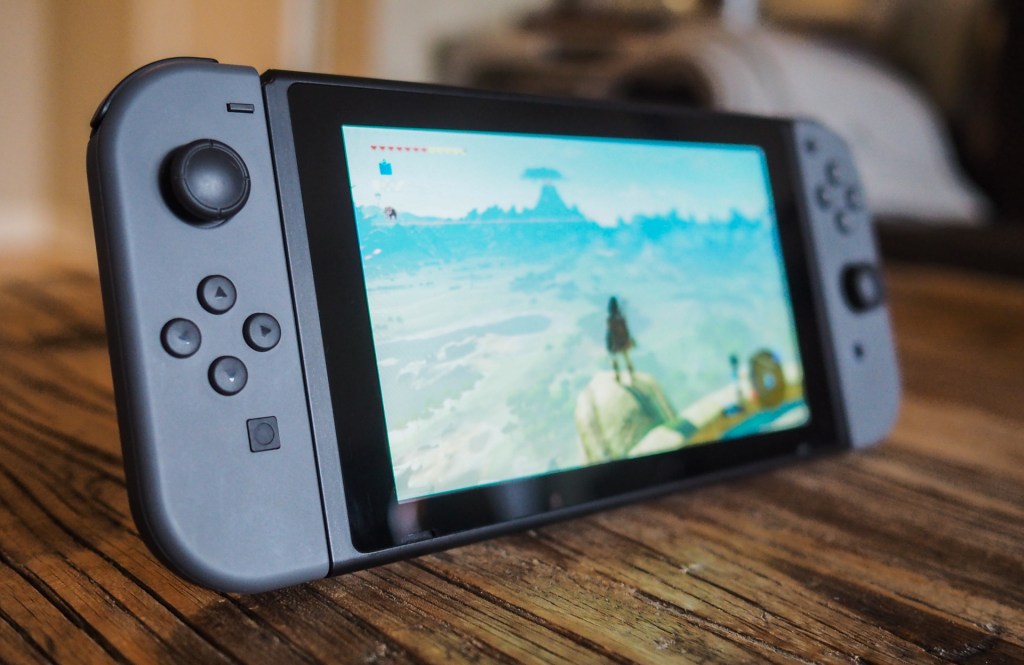
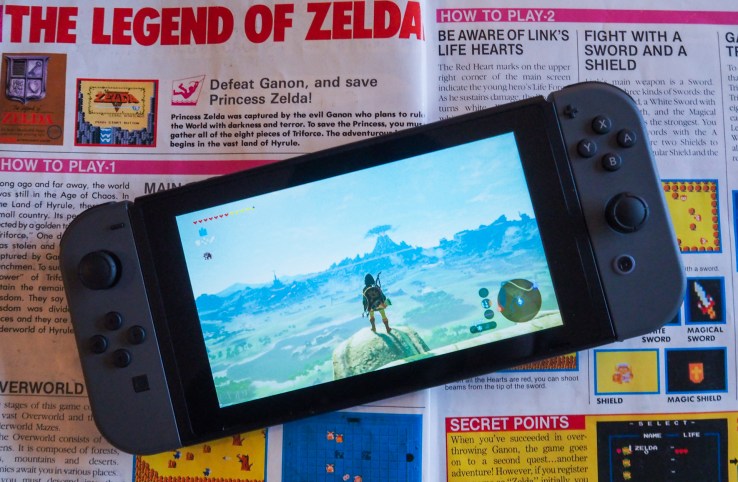
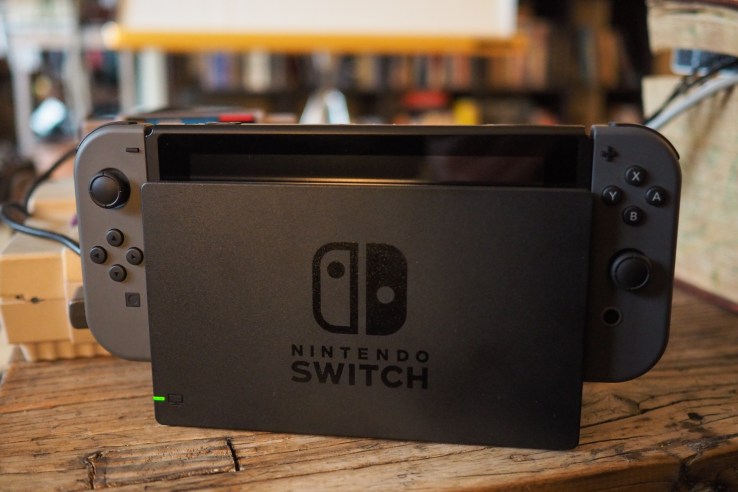







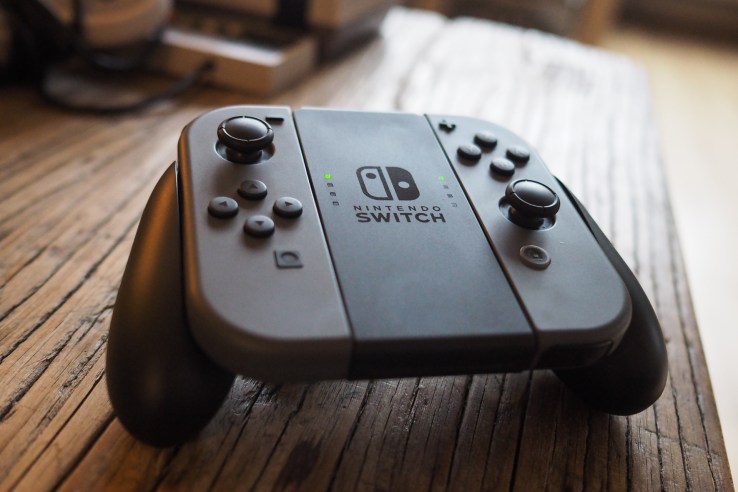






























Comment